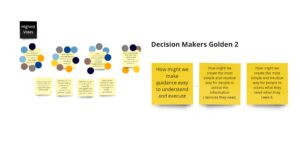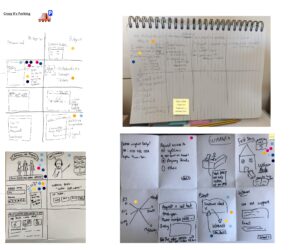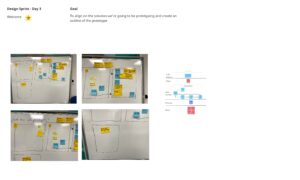The Essex County Council Intranet team ran a 5-half-day design sprint to tackle the problem that around 10% of our workforce who do not have ECC credentials are facing with accessing internal systems.
The current setup requires an Essex.gov email address for employees to complete essential journeys such as booking annual leave or logging sickness.
The design sprint is a quick structured way of tackling big problems and getting answers to critical questions. Over 5 days, the Design Sprint is broken down into 6 phases: Understand, Define, Sketch, Decide, Prototype and Validate.
As we're moving towards the private beta phase of our new open intranet built-in LocalGov Drupal we want to remove access barriers and become truly inclusive.
We’ve followed the Google Ventures (GV) Design Sprint methodologies with the difference that days were reduced to half days due to availability and sessions were partially held online.
Our Approach
Monday – Understanding
On Monday, the team focused on building a shared understanding of the problem.
The session started with an icebreaker as important stakeholders joined us, and some people didn't know each other. Following the introduction, we gave the team an overview of the week and had Claire from the research team present the research findings.
We then handed over to the stakeholders, who shared their understanding and knowledge of the problem. Following the insights we gathered, we moved into turning these into opportunities for our design by writing How might we statements.

Tuesday- Solution generation
Tuesday's focus was on sketching with an emphasis on critical thinking. The session started with a warm-up exercise by Thomas where we got to design the worst possible box for a Teddy.
We took some time to find design inspiration and looked for how other organisations might have tackled a similar problem.
After a quick discussion and some rough idea generating, we jumped into Crazy 8s and solution sketching and voted as a team on the ideas we wanted to take forward.

Wednesday – Decide and create outline for prototype
Following discussion and decision making with our stakeholders on what solution was technically feasible, we created an outline for the prototype.
It was decided that we would prototype a sign-in page and multiple help with requesting access pages, as well as a form that requires the user to enter their details with their National Insurance number to be identified as an employee.

Thursday- Prototyping
On Thursday Jessica worked on the prototype in Figma, while Thomas worked on getting the research script and outline ready for user testing.

Friday – Target user testing and presenting back to stakeholders
Friday was the last day of the sprint, and the team went onsite to Danbury to test the prototype with three people at Essex Outdoors.
We had two versions of the proposed solution, one where the user would fill in a form within the intranet and another where the user would be redirected to an external form from the intranet.
After the research sessions, we presented our findings back to the business.
What we learned from testing
If we were to implement the proposed solution:
- managers would be freed up from dealing with staff requests by empowering staff to self-serve
- employees felt that they wouldn’t have to burden their managers with extra work but rather can-do things on their own
- people trust Essex County Council with their personal data and would happily fill a form on the intranet and even external forms
Some improvements we’d need to make to the proposed solution:
- users are unfamiliar with the back-office process of identifying if they are an employee and would want to understand why they’d need to provide their NI Number and Date of Birth
- users want to be given the option to validate their identity by other means such as uploading a photo ID or drivers licence
- information should be visible on the landing page and at the top of pages, so they do not have to scroll
Quotes
“I like that I can deal with my own problems myself and get the answers back myself without getting my manager involved.” – Employee of Essex County Council
“I am doing so many requests on behalf of people. Every time there is an issue… (related to access and services associated with it). I have to do it for them. If they can do it themselves, I can do other things.” – Manager at Essex County Council
Lessons Learned
Design Sprints are a great way to tackle large complex problems where immediate solutions may not be apparent. Having stakeholders involved in the sprint is important and helps with discussions and the understanding of what is feasible and where our solutions may need revisiting.
For all participants to be available for the full sprint the project should be planned at least two weeks in advance.
Leave a comment